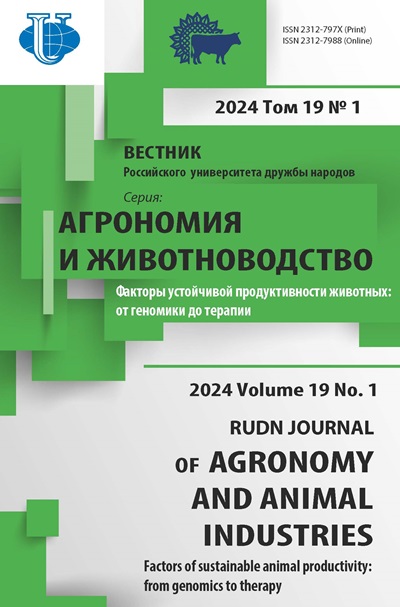Opportunities and prospects biosensor technologies for food analysis
- Authors: Butusov LA1,2, Chudinova GK2,3, Boruleva EA3, Kochneva MV1, Omelchenko VI1, Shorygina AV1, Alikberova TA1
-
Affiliations:
- Рeoples’ Friendship University of Russia (RUDN University)
- Institute of General Physics A. Prokhorov RAS
- National Research Nuclear University “MEPhI”
- Issue: Vol 13, No 1 (2018)
- Pages: 70-77
- Section: Veterinary sanitary inspection
- URL: https://agrojournal.rudn.ru/agronomy/article/view/18085
- DOI: https://doi.org/10.22363/2312-797X-2018-13-1-70-77
Cite item
Full Text
Abstract
Existing developments in the field of biosensor technologies with the possibility of practical application for establishing food safety indicators were considered. The classification of biosensors is described depending on the physical phenomena underlying its work, the essence and examples of specific developments for the determination of microorganisms, heavy metals and antibiotics in food products are presented. Prospects of biosensor technologies in the food industry are estimated.
About the authors
L A Butusov
Рeoples’ Friendship University of Russia (RUDN University); Institute of General Physics A. Prokhorov RAS
Author for correspondence.
Email: leonid.butusov@ya.ru
ассистент агроинженерного департамента Аграрно-технологического института Российского университета дружбы народов
Miklukho-Maklaya st., 6, Moscow, Russia, 117198; Vavilov st. 38, Moscow, Russia, 119991G K Chudinova
Institute of General Physics A. Prokhorov RAS; National Research Nuclear University “MEPhI”
Email: mvkochneva@mail.ru
доктор физико-математических наук, профессор, ведущий научный сотрудник Центра естественнонаучных исследований Института общей физики им. А.М. Прохорова РАН, профессор кафедры лазерных микро- и нанотехнологий Национального исследовательского ядерного университета «МИФИ»
Vavilov st. 38, Moscow, Russia, 119991; Kashirskoye sh., 31, Moscow, Russia, 115409E A Boruleva
National Research Nuclear University “MEPhI”
Email: mvkochneva@mail.ru
аспирант Национального исследовательского ядерного университета «МИФИ»
Kashirskoye sh., 31, Moscow, Russia, 115409M V Kochneva
Рeoples’ Friendship University of Russia (RUDN University)
Email: mvkochneva@mail.ru
кандидат технических наук, доцент агроинженерного департамента Аграрно-технологического института Российского университета дружбы народов
Miklukho-Maklaya st., 6, Moscow, Russia, 117198V I Omelchenko
Рeoples’ Friendship University of Russia (RUDN University)
Email: omelchenko.viky@yandex.ru
студент 4 курса Российского университета дружбы народов
Miklukho-Maklaya st., 6, Moscow, Russia, 117198A V Shorygina
Рeoples’ Friendship University of Russia (RUDN University)
Email: avshorygina@gmail.com
студент 2 курса магистратуры Российского университета дружбы народов
Miklukho-Maklaya st., 6, Moscow, Russia, 117198T A Alikberova
Рeoples’ Friendship University of Russia (RUDN University)
Email: tanya.vinogra2014@yandex.ru
студентка 2 курса магистратуры Российского университета дружбы народов
Miklukho-Maklaya st., 6, Moscow, Russia, 117198References
- Velusamy V., Arshak K., Korostynska O., Oliwa K., Adley C. An overview of foodborne pathogen detection: In the prespective of biosensors. Biotechnology advances. 2010; Vol. 28(2): 232—254.
- Arugula M.A., Simonian A. Novel trends in affinity biosensors: current challenges and perspectives. Measurement Science and Technology. 2014; Vol. 25(3):032001—032022.
- Mass-Sensitive Biosensor Systems to Determine the Membrane Interaction of Analytes. National Center for Biotechnology Information, U.S. National Library of Medicine 2017; 1520:145—157.
- Nowak B., Müffling T., Chaunchom S., Hartung J. Salmonella contamination in pigs at slaughter and on the farm: A field studyusing an antibody ELISA test and a PCR technique. International Journal of Food Microbiology. 2007; Vol. 115(3):259—267.
- Wang Z.P., Xu H., Wu J., Ye J., Yang Z. Sensitive detection of Salmonella with fluorescent bioconjugated nanoparticles probe. Food Chemistry. 2011; Vol. 125(2):779—784.
- CDC. 2015 Food Safety Report. Centers for Disease Control and Prevention; USA, IL: 2016.
- Bokken G.C.M.B., Corbee R.J., Knapen F., Bergwerff A.A. Immunochemical detection of Salmonella group B, D and E using an optical surface plasmon resonance biosensor. FEMS Microbiology Letters. 2003; Vol. 222(1):75—82.
- Mazumdar S.D., Hartmann M., Kampfer P., Keusgen M. Rapid method for detection of Salmonella in milk by surface plasmon resonance (SPR). Biosensors and Bioelectronics. 2007; Vol. 22(9—10):2040—2046.
- Singh A., Verma H.N., Arora K. Surface Plasmon Resonance Based Label-Free Detection of Salmonella using DNA Self Assembly. Applied Biochemistry and Biotechnology. 2015; Vol. 175(3):1330–1343.
- Vaisocherová-Lísalová H., Víšová I., Ermini M.L., Špringer T., Song X.C. Mrázek J., Lamačová J., Lynn N. S Šedivák P. Homol J. Low-fouling surface plasmon resonance biosensor for multi-step detection of foodborne bacterial pathogens in complex food samples. Biosensors and Bioelectronics. 2016; Vol. 80:84—90.
- Romanov V., Galelyuka I., Glushkov V., Starodub N., Son‘ko R. P7 — Optical Immune Biosensor Based on SPR for the Detection of Salmonella Typhimurium. In: Proceedings OPTO 2011. In: AMA Conferences; 2011; Nurnberg. 139—144.
- Rahn K., De Grandis S.A., Clarke R.C., McEwen S.A., Galán J.E., Ginocchio C., Curtiss R., Gyles C.L. Amplification of an invA gene sequence of Salmonella typhimurium by polymerase chain reaction as a specific method of detection of Salmonella. Molecular and Cellular Probes. 1992; Vol. 6(4):271—279.
- Chai Y., Li S., Horikawa S., Mi-Kyung Park, Vodyanoy V., Bryan A. Rapid and Sensitive Detection of Salmonella Typhimurium on Eggshells by Using Wireless Biosensors. Journal of Food Protection. 2012; Vol. 75(4):631—636.
- Zhang L., Zhang A., Du D., Lin Y. Biosensor based on Prussian blue nanocubes/reduced graphene oxide nanocomposite for detection of organophosphorus pesticides. Nanoscale. 2012; Vol. 4(15):4674—4679.
- Arduini F., Amine A. Biosensors based on enzyme inhibition. In: Biosensors Based on Aptamers and Enzymes. Berlin: p. 299—326. ISSN: 0724-6145.
- Gammoudi I., Tarbague H., Othmane A., Moynet D., Rebiere D., Kalfat R., Dejous C. Love-wave bacteria-based sensor for the detection of heavy metal toxicity in liquid medium. Biosensor & Bioelectronics. 2010; Vol. 26(4):1723—1726.
- Long F., Zhu A., Shi H., Wang H., Liu J. Rapid on-site/in-situ detection of heavy metal ions in environmental water using a structure-switching DNA optical biosensor. Scientific Reports. 2013; Vol. 3: Article number: 2308.
- Fluorescent optical DNA-biosensor: pat. 2668787 RF IPK51 C1 / Butusov L.A., Nagovitsyn I.A., Kurilkin V.V., Chudinova G.K.; the applicant and the patent holder — Russian University of Peoples Friendship. — No. 2016107983; claimed. 03/04/2016; publ. 18.04.2017, Bul. № 11. http://www1.fips.ru/wps/PA_FipsPub/res/Doc.
- Pautke C., Vogt S., Kreutzer K., Haczek C., Wexel G., Kolk A., Imhoff A.B., Zitzelsberger H., Milz S., Tischer T. Characterization of eight different tetracyclines: advances in fluorescence bone labeling. Journal of Anatomy 2010; Vol. 217(1): 76—82.
















